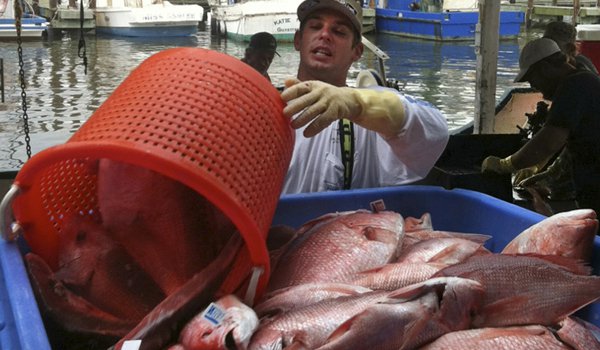NOAA Fisheries has expanded the catch limits for both the commercial and the recreational red snapper fisheries in the Gulf of Mexico.
Despite “uncertainties” in the most-recent count of red snapper in the Gulf of Mexico, NOAA increased the total annual catch limit by 300,000 pounds to 15.4 million pounds for 2023, and the overfishing limit from 15.5 million pounds to 25.6 million pounds.
Of the annual catch limit, the share dedicated to commercial fishermen will move from 7.7 million pounds to 7.854 million pounds, representing 51 percent of the catch limit, and the recreational share will increase from 7.399 million pounds to 7.546 million pounds, or 49 percent of the total limit. Charter fishermen will receive 42 percent of the recreational catch limit, or 3.192 million pounds.
Under the new limits, Alabama will be allowed to catch 558,200 pounds, Florida will receive 2.069 million pounds, Louisiana gets 882,000 pounds, Mississippi gets 59,000 pounds, and Texas gets 270,000 pounds whole-weight equivalent.
NOAA said two interim analyses conducted in 2021 indicated catch levels could be increased for the fishery, including the so-called “Great Red Snapper Count,” which reported stock biomass of Gulf red snapper was approximately three times the previous estimate, NOAA said in its 2 December announcement.
The undercount was primarily due to a misestimation of the number of snapper living above so-called “uncharacterized bottom,” or areas of the ocean without hard bottom, including natural and artificial reefs. In response to that finding, the result of a review by Gulf of Mexico Fishery Management Council’s Scientific and Statistical Committee, NOAA increased its overfishing limit to account for uncertainties in the Great Red Snapper Count survey.
The other major update made by NOAA in regard to the red snapper fishery was in creating a “common currency” to account for varying regulatory structures in each U.S. state bordering the Gulf of Mexico. The issue had been exacerbated as NOAA ceded some control of the fishery to the states under Amendment 50, which was adopted in 2019. The common currency calculations are made possible by a calibration ratio developed jointly by the states and NOAA Fisheries’ Office of Science and Technology.
In a statement, the Gulf of Mexico Reef Fish Shareholders’ Alliance, representing the commercial fishery, said the move was “an important step toward bringing the recreational red snapper fishery closer to compliance with the Magnuson-Stevens Fishery Conservation and Management Act."
“This deliberative process involved extensive analysis and repeated communications with the gulf states, having been flagged as an issue more than five years ago,” Alliance Deputy Director Eric Brazer said. “Since then, the gulf states have been managing the red snapper private angler sector and collecting catch data with five different state-specific surveys. However, these different surveys are not directly comparable, since there isn’t a standardized way to count fish between the states and the data NOAA Fisheries collects. In other words, it’s like comparing apples to oranges to bananas.”
The group blamed the lack of common currency calculator for allowing the recreational and charter sector to overfish its allocation by two million pounds between 2018 and 2021.
“This serial overharvesting happened as the Gulf of Mexico Fishery Management Council (Gulf Council) failed to develop and approve a viable solution in a timely manner and ignored the advice from NOAA Fisheries’ general counsel that a lack of ‘common currency’ was a violation of MSA,” Brazer said. “But these overages have not been paid back as required by law; so once again, private angler overfishing – driven by and shrouded in a lack of ‘common currency’ – is being tolerated and excused. This results in harm to the stock, which, in turn, harms commercial fishing business and our ability to feed the nation.”
Brazer said as a result, the Gulf of Mexico red snapper fishery has gone into decline since 2016.
“Because there was no common currency or calibration and because we are seeing troubling trends on the water, the Shareholders’ Alliance cannot support the part of this rule that increases the red snapper average catch limit,” he said. “We wish we could. Commercial fishermen and fishing businesses throughout the Gulf could use the additional fish as seafood consumers in this country have an increased its appetite for seafood - including red snapper.
"We wish the stock was healthy enough to sustain this extra pressure. But it’s not. We cannot, in good faith, support an increase at this time when there are so many warning flags that this stock is in need of more protection.”
“Environmental Defense Fund (EDF) supports this final rule to ensure the red snapper fishery continues to rebuild, that management of the fishery is compliant with federal law, and that fishing levels are sustainable,” Haukebo said. “Throughout the drafting of the state management program for private recreational red snapper, EDF has been supportive of a solution that provides private anglers secure access to the resource while ensuring that each sector adheres to their respective red snapper catch limits, a legally required component to ensure the stock rebuilds and leaves a thriving fishery for future generations.
"We encourage NMFS and the state fishery agencies in the Gulf to continue working together to update the calibration ratios through science-based decision making to ensure a healthy and abundant red snapper fishery.”
The story first appeared on SeafoodSource.com and is republished here with permission.







